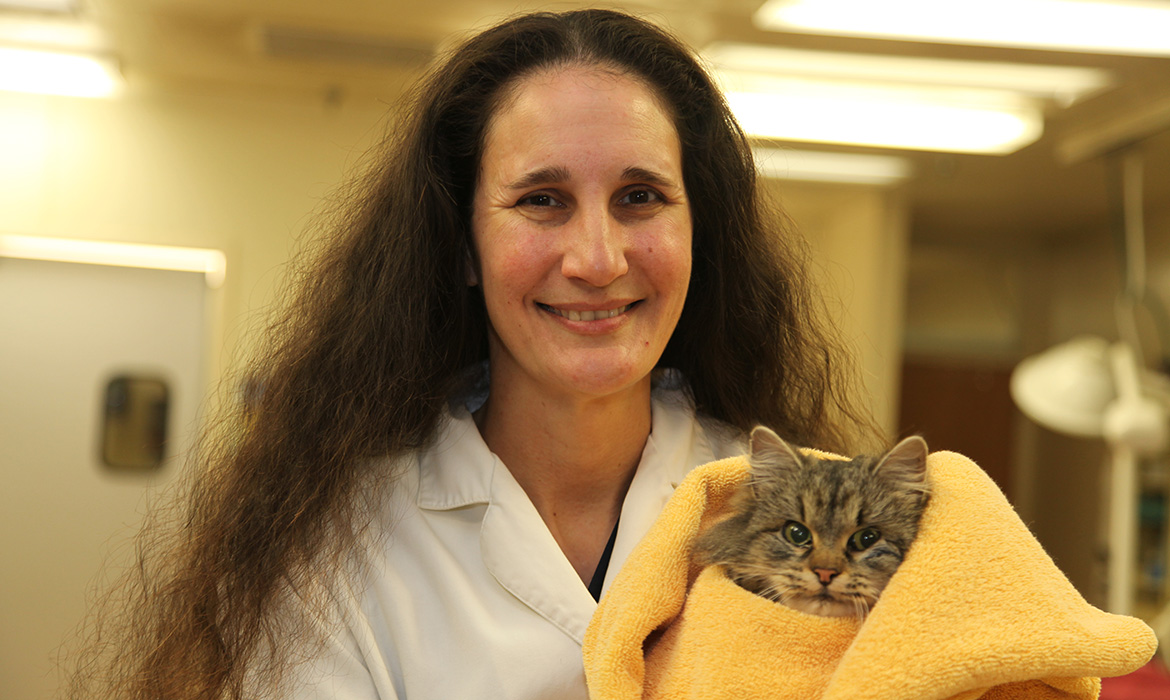
New Year’s Resolutions for a Healthier, Happier Cat
Monday, January 6, 2020
Cat owners can make 2020 a happy new year for their pets.
Providing a secure home environment and working with your veterinarian to identify any problems early will improve your cat’s physical and mental health.
To encourage a healthy feline lifestyle, the American Association of Feline Practitioners outlines five pillars of a healthy environment:
Safety: Cats need a safe place to rest, sleep and hide. Place their carrier in an area where they like to rest. Furnish it with soft, familiar smelling bedding, and include treats, toys and catnip or synthetic feline facial pheromones. (Bonus: Your cat will associate the carrier with safety and comfort when they need to go for a checkup or head to the tornado shelter.) Cats also prefer vertical spaces, such as cat trees, to survey their realm from above.
Resources: Create an environment that provides each cat his/her own personal and separate key resources to help your cat feel safe and comfortable.
a. Food and water: Provide individual food and water dishes in separate locations.
b. Litterbox:
• proper size — 1.5 times body length
• placement — out of high-traffic areas, but easy to access
• litter type — unscented and clumping
• number — one per cat, plus one extra
• clean — scoop at least once daily
• uncovered — no lid please
c. Scratching areas: Scratching allows cats to stretch their muscles, sharpen and shed nails, and mark their territory visually and with scent.
d. Resting area: Provide each cat his/her own place to retreat and feel protected.
Opportunity to play/hunt: Exercise reduces stress and allows you to bond with your cat. Make time for interactive play with your cat, and let them catch their “prey” intermittently. Frequently rotate toys to prevent boredom. Food puzzles are a clever way to get your cat to hunt for their meals.
Positive, consistent and predictable human interaction: Respect your cat’s preferences and never force them to interact with you or other people.
Respect for their keen sense of smell: Cats scent-mark their environmental boundaries with pheromones and use their sense of smell to evaluate their surroundings. Unfamiliar and strong scents can be scary for cats. Using a synthetic feline facial pheromone spray, wipe, or wall outlet plug-in can help ease tension in some multi-cat households.
Cats are masters at hiding illness, and they age much faster than we do. Regular and thorough physical exams are crucial to your cat’s well-being. Your veterinarian can detect changes that can affect your cat’s health before conditions become painful or more costly. Some suggestions for easing the trauma of a veterinary visit:
Pre-visit: Preparing for your veterinary visit can make a huge difference in your cat’s (and your) stress level. Choose a cat-friendly carrier and make it a normal part of his everyday environment. The carrier should have hard sides, a removable top half/top opening, front opening, and soft, familiar-smelling bedding inside. Synthetic pheromone spray or wipes can also help decrease travel stress for your cat. Give yourself adequate travel time and play soothing music during the ride. Communicate with your veterinarian if you feel that your cat would benefit from calming medications prior to the visit. Never give your cat any human medication without consulting your veterinarian; many human medications are toxic to our feline friends.
During the visit: Communicate any changes to your cat’s behavior, appetite or activity level. Work with your veterinarian to design a vaccination and parasite prevention protocol to fit your cat’s lifestyle. In Oklahoma, all pets need flea and heartworm prevention year-round, and outdoor cats need tick prevention as well. While you are there, ask to have your cat’s microchip checked so she can find her way home if she ever gets lost.
Post-visit: In multi-cat households, the return home can be stressful too. Ease the transition by using synthetic facial pheromones (Feliway®), allowing the returning cat some space upon arrival, and even placing the returning cat in a separate room for a few hours. Allow him to come out of the carrier on his own.
Cats often do not express easily recognizable signs of stress, pain or sickness. Being proactive and meeting appropriate environmental needs can help avoid stressors that can cause unwanted behaviors and impact medical health.
For more information on reducing your cat’s stress and creating a cat-friendly home, visit www.catfriendly.com and www.fearfreehappyhomes.com.
STORY BY: Sarah Peakheart, DVM, an assistant professor of shelter surgery in the Department of Veterinary Clinical Sciences at Oklahoma State University’s College of Veterinary Medicine.
